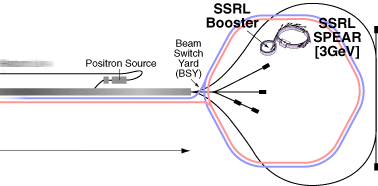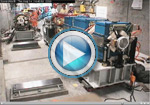Experimental Facilities : The SPEAR Storage Ring
Stanford University has a long history of involvement in the development and use of colliding-beam storage rings for particle physics research. The first such machine at Stanford was a small electron-electron collider, shaped like a figure eight, located on the main campus. A collaborative effort between physicists from Princeton and Stanford Universities, this project produced the first physics results ever obtained with the colliding-beam technique.
 The next in the succession of Stanford colliders was the SPEAR (Stanford Positron Electron Accelerating Ring) machine at SLAC, completed in 1972. SPEAR consists of a single ring some 80 meters in diameter, in which counter-rotating beams of electrons and positrons were circulated at energies up to 4 GeV. In terms of the rich harvest of discoveries it has yielded, it has been the most cost-effective machine ever built in the field of high energy physics. In 1990, the machine was dedicated to synchrotron radiation research.
The next in the succession of Stanford colliders was the SPEAR (Stanford Positron Electron Accelerating Ring) machine at SLAC, completed in 1972. SPEAR consists of a single ring some 80 meters in diameter, in which counter-rotating beams of electrons and positrons were circulated at energies up to 4 GeV. In terms of the rich harvest of discoveries it has yielded, it has been the most cost-effective machine ever built in the field of high energy physics. In 1990, the machine was dedicated to synchrotron radiation research.
Two particular SPEAR discoveries stand out. The first was the 1974 discovery of a particle called the J/psi that is made up of a combination of a quark and an antiquark of an entirely new kind. Before this discovery only three types of quarks were known, but the discovery of this new quark (called charm) served as convincing evidence that the basic idea of the quark substructure of matter was in fact valid. This work was recognized by the award of the 1976 Nobel Prize in Physics to Burton Richter of SLAC, an award he shared with Samuel C. C. Ting of MIT for the simultaneous discovery of this new particle at Brookhaven National Laboratory.
The second revolutionary discovery made at SPEAR was that of a new particle called the tau, which turned out to be the third in the sequence of electrically charged elementary particles called leptons. The first lepton discovered was theelectron, found in 1897; the second was the muon (1937); and the third was the tau, discovered at SPEAR in 1976. Martin Perl of SLAC was awarded the 1982 Wolf Prize and shared the 1995 Nobel Prize in Physics for its discovery.

SPEAR and SSRL
SPEAR also produces intense beam of synchrotron radiation -- ultraviolet and x-ray photons emitted by the circulating electron beams -- that have found extensive use for basic and applied research in such fields as materials science and medicine.
 At the beginning of SPEAR's operation, the x-rays (synchrotron radiation) given off by the particles as they moved around the curves in the storage ring were considered to be both a waste of energy and a practical nuisance by high energy physicists interested in particle physics.
At the beginning of SPEAR's operation, the x-rays (synchrotron radiation) given off by the particles as they moved around the curves in the storage ring were considered to be both a waste of energy and a practical nuisance by high energy physicists interested in particle physics.
A few far-sighted individuals realized what they had was the world's most intense x-ray source, many times more powerful than any medical accelerator could produce. It was soon realized that these x-rays could be used to study many aspects of the structure of matter at the atomic and molecular scale, from surface properties of semiconductor materials to the structure of protein molecules.
Since that time synchrotron radiation has become an indispensable tool for discovering material properties and over 50 synchrotron radiation labs have opened up around the world due to the pioneering work done at the Stanford Synchrotron Radiation Lightsource (SSRL) at SLAC.
Since 1990, SPEAR has been used exclusively for synchrotron radiation physics at SSRL, with only a single beam of stored electrons. SSRL now has its own particle accelerator to feed it electron beams, so it can operate independently of the linac for a wide variety of synchrotron-radiation-based studies.

 SPEAR is filled with bunches of electrons and positrons traveling in opposite directions around the ring. The particles circulate in an evacuated pipe. Dipole magnets placed at regular intervals provide the force to steer the particles around the ring. The particles are fed to SPEAR at the desired energy from an accelerator, originally the two mile SLAC linac. As the charged particles circulate they lose energy by synchrotron radiation. This energy is restored to the bunches each time they pass through the accelerating cavity that is part of the ring. The electric fields in this cavity provide the force to reaccelerate the bunches.
SPEAR is filled with bunches of electrons and positrons traveling in opposite directions around the ring. The particles circulate in an evacuated pipe. Dipole magnets placed at regular intervals provide the force to steer the particles around the ring. The particles are fed to SPEAR at the desired energy from an accelerator, originally the two mile SLAC linac. As the charged particles circulate they lose energy by synchrotron radiation. This energy is restored to the bunches each time they pass through the accelerating cavity that is part of the ring. The electric fields in this cavity provide the force to reaccelerate the bunches.




